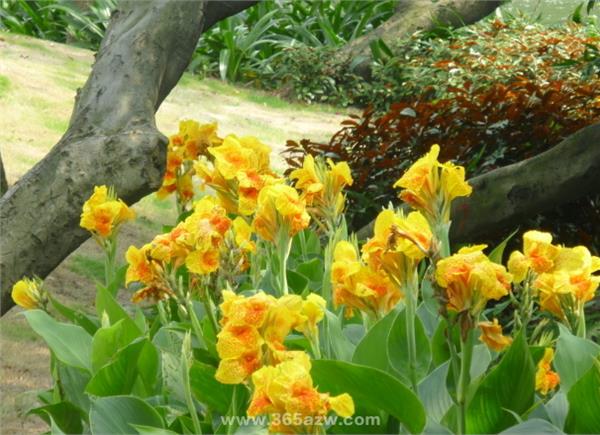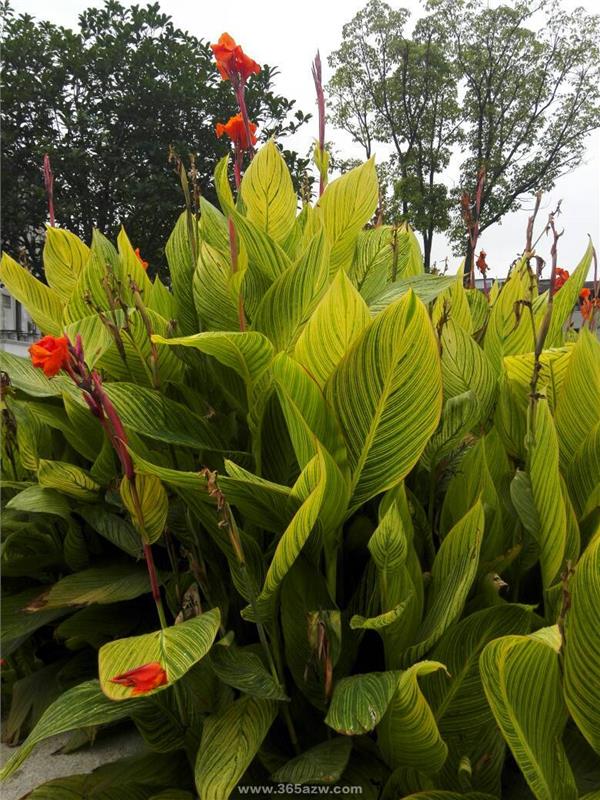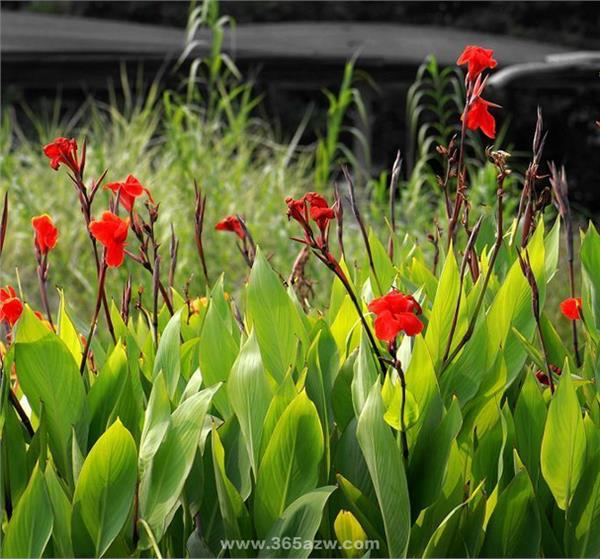Growth habits, propagation and cultivation methods of flower-leaf canna
Flower-leaf canna is strong and extensive, and can grow normally in full light or semi-shade environment. Let's take a look at the growth habits, reproduction and cultivation methods of flower-leaf canna.

Growth habits, propagation and cultivation methods of flower-leaf canna
Flower-leaf canna is a horticultural variety of canna. Perennial perennial herb. Dwarf, plant tall 50~80cm, with stout rhizomes, leaves broadly oval, alternate, with obvious midrib and pinnate lateral veins, inlaid with soil yellow, milky yellow, green and yellow colors. Terminal raceme with about 10 flowers, red, slightly smaller than terrestrial canna. The flowering period is from July to October, and the annual green period is about 240 days.
Flower-leaf canna is one of the newly introduced canna varieties in recent years. Like canna, it has strong growth, few diseases and insects, and a long flowering period. what is more, its plant is low, only about 50 meters high, and it is very suitable for potted plants. moreover, its parallel veins are golden, and on the new leaves that roll and feel comfortable, if the make-up cuisine sleeves are embedded with gold thread, they are delicate and lovely.
Propagation and cultivation
The propagation of Canna plantain is mainly divided into individual plants, which is usually carried out in April or May. When ramet, the underground stem is dug out from the soil, and the tuber is divided into several pieces with a sharp knife, each with 2-3 buds, which are directly planted in the open field or planted in the basin.
Flower-leaf canna is strong and extensive, and can grow normally in full light or semi-shaded environment. During cultivation, the soil needs to be deeply turned into the sun to improve the soil temperature, sterilize and disinfect, apply organic fertilizer, cluster planting or planting in pieces. The peak growing season is from July to October from summer to autumn, so it is necessary to strengthen the management of light, fertilizer, water and ventilation, and cut off overdense plants and flowering plants in time. It needs to be replanted after cultivation for 1 ~ 2 years. The main diseases and pests of flower-leaf canna are snail, slug, blow scale, whitefly, scab and so on.

Pot technology
It is suitable to choose dwarf varieties for potted canna. Generally, the proportion of rotten leaf soil, vegetable garden soil and rice chaff ash is 1.5-0.5, and a small amount of bean cake, bone meal and other fertilizers are added.
From March to April in spring, take out the tuber, remove the rotten part, select the stem with 2-3 strong teeth and bury it in the basin soil, preferably with the bud tip exposed. Because canna is very fond of fertilizer and resistance to moisture, the basin should be watered thoroughly. When the fifth leaf grows, mature topdressing is applied every 7-10 days, and then watered after fertilization. Generally, 1% ferrous sulfate fertilizer and water is applied once a month, or a small amount of plant ash is added to make the stem straight and strong, the leaves green and thick, and the flowers bright. Stop fertilizing at the flowering stage. If you put it in a cooler place during flowering, you can prolong the flowering period. When the flower at the end of the stem lags behind, the stem branch should be cut off from the base at any time in order to sprout new buds and grow flower branches to blossom one after another.
Potted canna sometimes has scorched and yellowed leaves, mainly due to excessive application of ferrous sulfate or drought and hot sun exposure. In the hot summer, if poured too cold water will also cause the leaf edge scorch, such as in the heat of summer fertilization is too thick, there will be cauterization of the rhizome to "burn". In addition, when the temperature is above 40, the canna can be moved to a cool and ventilated place. Before and after Frosts Descent, the potted canna can be moved to a temperature of 5-10 to survive the winter safely, and fertilization should be stopped during the overwintering period.

Overwintering management
1. Think of it as an indoor flower. Please come in.
Flower-leaf canna is very pleasing to the eye as an indoor ornamental plant. Put the potted canna in a place with plenty of light and give the right amount of comprehensive fertilizer at the right time. Don't water too much. If the leaf is broken and wilted, cut the petiole to 4 inches long, and a new stalk will grow slowly.
two。 The canna in the garden, "see you next year."
Warm zone: canna is difficult to survive the winter at your place. You can dig it out of the garden and plant it next season. Or leave it in the soil for the winter. If winter frost threatens it, it would be a good idea to cover it with a lightweight blanket.
Cold zone: leave the beauty in the soil until the frost blackens the leaves (this is an inevitable consequence of summer flowering canna, except for Qiuhaitang plants treated before frost). Then cut the stem to 4 inches long. Dig up the bulbs carefully, brush the soil away, and break or cut the rhizomes to make sure that each rhizome has a visible leaf. Then put them in a dry and cold place to dry. Be careful not to hurt the roots. Remember to label the variety when the leaves are fully air-dried. When dry, cut off some of the remaining leaves and wrap the bouquet in several layers of vermiculite. It would be better to wrap it with a layer of moss. Store it in a dry and cool place until next spring.

Next spring, indoor potted canna will take on a new look in the summer garden. The canna that grew eight weeks earlier than your previous planting date (from the end of the last frost) won two months of life.
Planted in spring. Choose high dry land to avoid stagnant water and apply sufficient base fertilizer before planting. If you want to bloom early, you must dig out the underground stem after the plant withered in December and put it in the greenhouse to sprout with wet sand to keep the temperature at 20-25 degrees Celsius. The rhizome was divided and planted indoors when it was dormant and germinated. When it came out in March, it could blossom 2 months earlier. Thin manure was applied once before flowering, and topdressing for 2 or 3 times during flowering. Cut off the residual flowers in time after flowering so as not to consume nutrients and make the new stems come out one after another and blossom continuously. In December, after the aboveground withered, the plant was cut off and covered with soil to prepare for safe overwintering. Remove the covering material next spring so that the new buds can be unearthed.
During the whole growth period, good light and ventilation should be maintained; the basin soil should be kept moist at ordinary times, and 20% cake fertilizer and water should be applied twice a month to prevent stagnant water in the basin during the rainy season. Cutting off the residual flowers after flowering can not only maintain a good ornamental effect, but also facilitate the opening of stubble flowers. In winter, it should be put indoors. If it is stored in the open air, it must be covered in order to survive the winter safely.
Flower-leaf canna is strong and extensive, and can grow normally in full light or semi-shaded environment. During cultivation, the soil needs to be deeply turned into the sun to improve the soil temperature, sterilize and disinfect, apply organic fertilizer, cluster planting or planting in pieces. The peak growing season is from July to October in summer, so it is necessary to strengthen the management of light, fertilizer, water and ventilation, and cut off the overdense plants and flowering plants in time. It needs to be replanted after cultivation for 1 ~ 2 years. The main diseases and pests of flower-leaf canna are snail, slug, blow scale, whitefly, scab and so on.
Next spring, indoor potted canna will take on a new look in the summer garden. The canna that grew eight weeks earlier than your previous planting date (from the end of the last frost) won two months of life.
Planted in spring. Choose high dry land to avoid stagnant water and apply sufficient base fertilizer before planting. If you want to bloom early, you must dig out the underground stem after the plant withered in December and put it in the greenhouse to sprout with wet sand to keep the temperature at 20-25 degrees Celsius. The rhizome was divided and planted indoors when it was dormant and germinated. When it came out in March, it could blossom 2 months earlier. Thin manure was applied once before flowering, and topdressing for 2 or 3 times during flowering. Cut off the residual flowers in time after flowering so as not to consume nutrients and make the new stems come out one after another and blossom continuously. In December, after the aboveground withered, the plant was cut off and covered with soil to prepare for safe overwintering. Remove the covering material next spring so that the new buds can be unearthed.
During the whole growth period, good light and ventilation should be maintained; the basin soil should be kept moist at ordinary times, and 20% cake fertilizer and water should be applied twice a month to prevent stagnant water in the basin during the rainy season. Cutting off the residual flowers after flowering can not only maintain a good ornamental effect, but also facilitate the opening of stubble flowers. In winter, it should be put indoors. If it is stored in the open air, it must be covered in order to survive the winter safely.
Flower-leaf canna is strong and extensive, and can grow normally in full light or semi-shaded environment. During cultivation, the soil needs to be deeply turned into the sun to improve the soil temperature, sterilize and disinfect, apply organic fertilizer, cluster planting or planting in pieces. The peak growing season is from July to October in summer, so it is necessary to strengthen the management of light, fertilizer, water and ventilation, and cut off the overdense plants and flowering plants in time. It needs to be replanted after cultivation for 1 ~ 2 years. The main diseases and pests of flower-leaf canna are snail, slug, blow scale, whitefly, scab and so on.
Related
- Wuhan Hospital Iron Tree Blooming Result Was Instantly Frightened by the Gardener Master
- Which variety of camellia is the most fragrant and best? Which one do you like best?
- What is the small blue coat, the breeding methods and matters needing attention of the succulent plant
- Dormancy time and maintenance management of succulent plants during dormancy
- Minas succulent how to raise, Minas succulent plant pictures
- What are the varieties of winter succulent plants
- How to raise succulent plants in twelve rolls? let's take a look at some experience of breeding twelve rolls.
- Attention should be paid to water control for succulent plants during dormant period (winter and summer)
- Watering experience of twelve rolls of succulent plants
- Techniques for fertilizing succulent plants. An article will let you know how to fertilize succulent plants.



